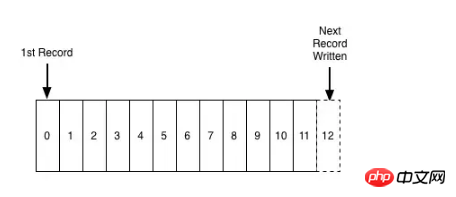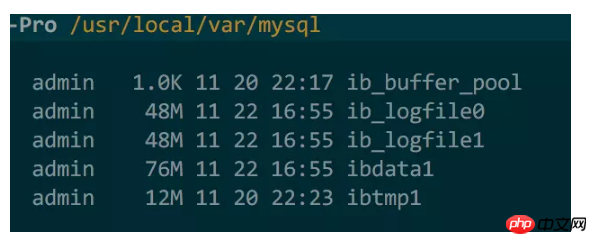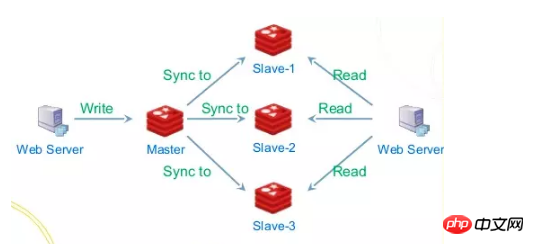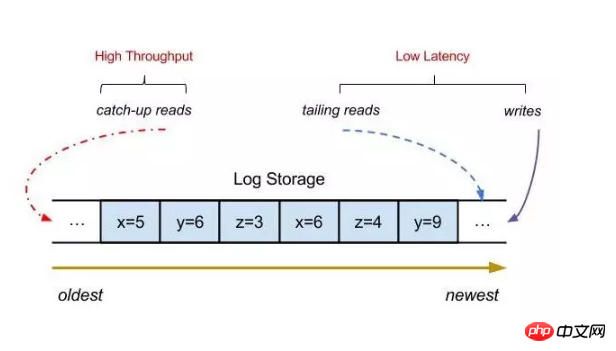
This article brings you a detailed introduction (pictures and text) about the distributed system core log. It has certain reference value. Friends in need can refer to it. I hope it will be helpful to you.
What is a log?
A log is a completely ordered sequence of records appended in chronological order. In fact, it is a special file format. The file is a word Section array, and the log here is a record data, but compared to the file, each record here is arranged in the relative order of time. It can be said that the log is the simplest storage model, and the reading is generally from From left to right, such as a message queue, the log file is generally written linearly, and the consumer reads sequentially starting from offset.
Due to the inherent characteristics of the log itself, records are inserted sequentially from left to right, which means that the records on the left are "older" than the records on the right, which means that we do not need to rely on the system clock. , this feature is very important for distributed systems.

Application of log
Application of log in database
The log is It is impossible to know when it will appear. It may be that the concept is too simple. In the database field, logs are more used to synchronize data and indexes when the system crashes, such as redo log in MySQL. Redo log is a disk-based data structure used to ensure data when the system hangs. The correctness and completeness of the system are also called write-ahead logs. For example, during the execution of a thing, the redo log will be written first, and then the actual changes will be applied. In this way, when the system recovers after a crash, it can be recreated based on the redo log. Put it back to restore the data (during the initialization process, there will be no client connection at this time). The log can also be used for synchronization between the database master and slave, because essentially, all operation records of the database have been written to the log. We only need to synchronize the log to the slave and replay it on the slave to achieve master-slave synchronization. Many other required components can also be implemented here. We can obtain all changes in the database by subscribing to the redo log, thereby implementing personalized business logic, such as auditing, cache synchronization, etc.
The application of logs in distributed systems

Distributed system services are essentially about state Changes here can be understood as state machines. Two independent processes (not dependent on the external environment, such as system clocks, external interfaces, etc.) given consistent inputs will produce consistent outputs and ultimately maintain a consistent state, and the log Because its inherent sequentiality does not depend on the system clock, it can be used to solve the problem of change orderliness.
We use this feature to solve many problems encountered in distributed systems. For example, in the standby node in RocketMQ, the main broker receives the client's request and records the log, and then synchronizes it to the slave in real time. The slave replays it locally. When the master hangs up, the slave can continue to process the request, such as rejecting the write request and continuing. Handle read requests. The log can not only record data, but also directly record operations, such as SQL statements.

The log is a key data structure to solve the consistency problem. The log is like a sequence of operations. Each record represents an instruction. For example, the widely used Paxos and Raft protocols are It is a consistency protocol built based on logs.

Application of logs in Message Queue
Logs can be easily used to process the inflow and outflow of data, and each data source can generate Your own log. The data sources here can come from various aspects, such as a certain event stream (page click, cache refresh reminder, database binlog change). We can centrally store the logs in a cluster, and subscribers can read the logs based on offset. For each record, apply your own changes based on the data and operations in each record.
The log here can be understood as a message queue, and the message queue can play the role of asynchronous decoupling and current limiting. Why do we say decoupling? Because for consumers and producers, the responsibilities of the two roles are very clear, they are responsible for producing messages and consuming messages, without caring about who is downstream or upstream, whether it is the change log of the database or a certain event. I don't need to care about a certain party at all. I only need to pay attention to the logs that interest me and each record in the logs.

We know that the QPS of the database is certain, and upper-layer applications can generally expand horizontally. At this time, if there is a sudden request scenario like Double 11, the database will be overwhelmed, then we can introduce message queues and add each team database The operations are written to the log, and another application is responsible for consuming these log records and applying them to the database. Even if the database hangs, you can continue processing from the position of the last message when recovering (both RocketMQ and Kafka support Exactly Once semantics), even if the speed of the producer is different from the speed of the consumer, there will be no impact. The log plays the role of a buffer here. It can store all records in the log and synchronize to the slave node regularly, so that The backlog capacity of messages can be greatly improved because writing logs is processed by the master node. Read requests are divided into two types, one is tail-read, which means that the consumption speed can keep up with the writing speed. One type of read can go directly to the cache, and the other type is a consumer that lags behind the write request. This type can be read from the slave node, so that through IO isolation and some file policies that come with the operating system, such as pagecache, cache pre- Reading, etc., performance can be greatly improved.

# Horizontal scalability is a very important feature in a distributed system. Problems that can be solved by adding machines are not a problem. So how to implement a message queue that can achieve horizontal expansion? If we have a stand-alone message queue, as the number of topics increases, IO, CPU, bandwidth, etc. will gradually become bottlenecks, and performance will slowly decrease. So how to proceed here? What about performance optimization?
1.topic/log sharding. Essentially, the messages written by topic are log records. As the number of writes increases, a single machine will slowly become a bottleneck. At this time We can divide a single topic into multiple sub-topics and assign each topic to a different machine. In this way, topics with a large amount of messages can be solved by adding machines, while some topics with a small amount of messages can be solved by adding machines. can be assigned to the same machine or not partitioned
2.group commit, for example, Kafka's producer client, when writing a message, first writes it to a local memory queue, and then writes the message according to each Partitions and nodes are summarized and submitted in batches. For the server side or broker side, this method can also be used, first writing to the pagecache, and then flushing the disk regularly. The flushing method can be determined according to the business. For example, financial services may adopt synchronization. The way to brush the disk.
3. Avoid useless data copies
4.IO isolation

The above is the detailed content of Detailed introduction of distributed system core log (picture and text). For more information, please follow other related articles on the PHP Chinese website!